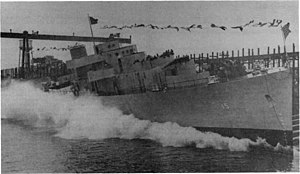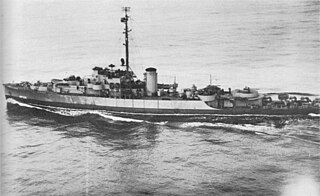
USS Gloucester (PF-22), a Tacoma-class frigate in commission from 1943 to 1945, was the second ship of the United States Navy to be named for Gloucester, Massachusetts. She later served in the Soviet Navy as EK-26 and in the Japan Maritime Self-Defense Force as JDS Tsuge (PF-12) and JDS Tsuge (PF-292).
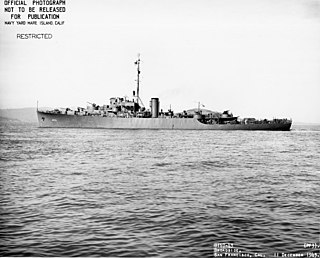
USS Tacoma (PG-111/PF-3), the lead ship of the Tacoma-class patrol frigates. The third ship of the United States Navy to be named for Tacoma, Washington, she was in commission from 1943 to 1945, and from 1949 to 1951. She also served in the Soviet Navy as EK-11 and in the Republic of Korea Navy as ROKS Taedong (PF-63).

USS Sausalito (PF-4), was a Tacoma-class patrol frigate in commission from 1944 to 1945 and from 1950 to 1952, was the only ship of the United States Navy to be named for Sausalito, California. She also served in the Soviet Navy as EK-16 and in the Republic of Korea Navy as ROKS Imchin (PF-66).

USS Sandusky (PF-54), a Tacoma-class frigate in commission from 1944 to 1945, was the second United States Navy ship of the name and the first to be named for Sandusky, Ohio. She later served in the Soviet Navy as EK-7 and in the Japan Maritime Self-Defense Force as JDS Nire (PF-7), Nire (PF-287) and as YAC-19.

USS San Pedro (PF-37), a Tacoma-class frigate in commission from 1943 to 1945, thus far has been the only ship of the United States Navy to be named for San Pedro, California. She later served in the Soviet Navy as EK-5 and in the Japan Maritime Self-Defense Force as Kaya (PF-8), Kaya (PF-288) and as YAC-23.

USS Uniontown (PF-65), a Tacoma-class frigate, was the only ship of the United States Navy to be named for Uniontown, Pennsylvania.
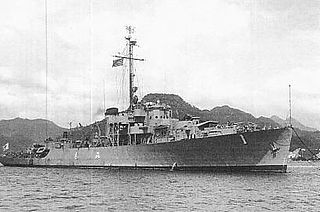
USS Poughkeepsie (PF-26), a Tacoma-class frigate in commission from 1944 to 1945, was the first ship of the United States Navy to be named for Poughkeepsie, New York. She later served in the Soviet Navy as EK-27 and in the Japan Maritime Self-Defense Force as JDS Momi (PF-4), JDS Momi (PF-284), and as YAC-13.

USS Allentown (PF-52), a United States Navy Tacoma-class frigate in commission from 1944 to 1945, has thus far been the only U.S. Navy ship to be named for Allentown, Pennsylvania. She later served in the Soviet Navy as EK-9 and in the Japan Maritime Self-Defense Force as JDS Ume (PF-9), JDS Ume (PF-289) and as YAC-14.

USS Albuquerque (PG-115/PF-7), a Tacoma-class patrol frigate in commission from 1943 to 1945 and from 1950 to 1953, was the first ship of the United States Navy to be named for Albuquerque, New Mexico. She also served in the Soviet Navy as EK-14 and in the Japan Maritime Self-Defense Force as JDS Tochi (PF-16/PF-296) and as YAC-15.
USS Gladwyne (PF-62), a Tacoma-class frigate, was the only ship of the United States Navy to be named for Gladwyne, Pennsylvania. Originally named Worcester after Worcester, Massachusetts, the name was changed in order to give it to new light cruiser USS Worcester (CL-144) then under construction.
USS Racine (PF-100), a Tacoma-class frigate, was the first ship of the United States Navy to be named for Racine, Wisconsin.
USS Gulfport (PF-20), a Tacoma-class frigate, was the second ship of the United States Navy to be named for Gulfport, Mississippi.

The second USS Long Beach (PF-34) was a Tacoma-class frigate in commission from 1943 to 1945. She later served in the Soviet Navy as EK-2 and then in the Japan Maritime Self-Defense Force as Shii (PF-17) and Shii (PF-297) and YAS-44.

USS Glendale (PF-36), a Tacoma-class patrol frigate, is the only ship of the United States Navy to be named for Glendale, California. In commission in the US Navy from 1943 to 1945, and from 1950 to 1951, she also served in the Soviet Navy as EK-6 from 1945 to 1949 and in the Royal Thai Navy as Tachin (PF-1) from 1951 to 2000.

USS Bangor (PF-16) was a United States Navy Tacoma-class frigate in commission from 1944 to 1946. Thus far, she has been the only U.S. Navy ship named for Bangor, Maine. She later served in United States Coast Guard as USCGC Bangor and in the Mexican Navy as ARM General José María Morelos and ARM Golfo de Tehuantepec.
USS Belfast (PF-35), the only ship of the name, was a United States Navy Tacoma-class frigate in commission from 1943 to 1945. She then served in the Soviet Navy as EK-3.

USS Burlington (PF-51) was a Tacoma-class frigate in commission from 1944 to 1945 and from 1951 to 1952, the only United States Navy ship thus far to have been named for Burlington, Iowa. She also served in the Soviet Navy as EK-21 and in the Colombian National Armada as ARC Almirante Brión.
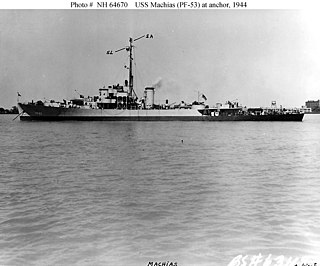
The second USS Machias (PF-53) was a United States Navy Tacoma-class frigate in commission from 1944 to 1945 which later served in the Soviet Navy as EK-4 and the Japan Maritime Self-Defense Force as JDS Nara (PF-2), JDS Nara (PF-282) and YTE-8.
The second USS Bath (PF-55) was a United States Navy Tacoma-class frigate in commission from 1944 to 1945 which later served in the Soviet Navy as EK-29 and the Japanese Maritime Self-Defense Force, with her Japanese name reported by various sources as JDS Maki (PF-18) and JDS Maki (PF-298), and later as YTE-9.
The second USS Brunswick (PF-68) was a United States Navy Tacoma-class frigate in commission from 1944 to 1946.
